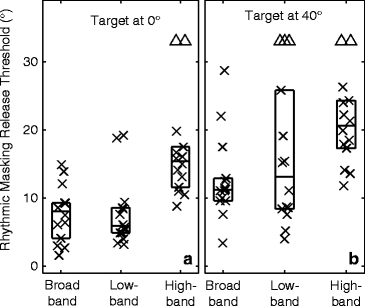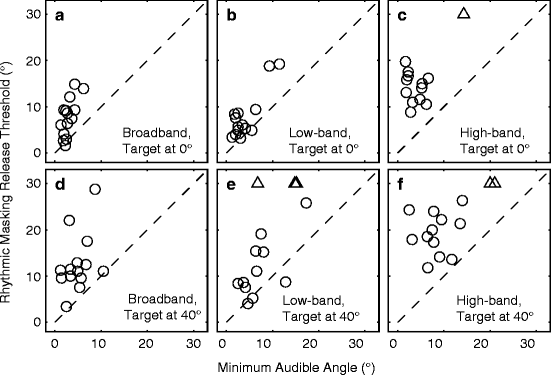Fig. 54.1
Rhythm discrimination by one listener. The dashed line at d′ = 1 indicates the criterion for threshold rhythm discrimination (From Middlebrooks and Onsan 2012)
Acuity was somewhat coarser when the target was located 40° to the listener’s right side (Fig. 54.1). Thresholds for this listener were 9° and 11° for maskers to the right or left of the target. The median across listeners in the broadband 40° target condition was 11.2°, which was significantly larger than in the 0° target condition (p < .0005). The 40° target condition is particularly interesting because the target and maskers all were located within the same sound hemifield. Several recent reports have emphasized that localization acuity is finest for targets around the frontal midline and have argued that localization might rely on the relative activity between left- and right-tuned neural populations (e.g., McAlpine and Grothe 2003; Stecker et al. 2005; Phillips 2007). The present results demonstrate that high-acuity spatial stream segregation can be accomplished even when both target and masker activate primarily right-tuned neurons.
Performance across the broadband, low-band, and high-band conditions for the seven listeners is shown in Fig. 54.2. In both 0° and 40° target conditions, performance varied significantly across passband conditions (p < .0005 and p < .02 for 0° and 40° targets, respectively; Kruskal-Wallis test). That passband dependence, however, almost entirely reflected the relatively poor performance in the high-band condition. There was no significant difference between broadband and low-pass conditions (p > .05) but significantly broader thresholds for pair-wise comparison of high-band versus broadband conditions (p < .005 and p < .05 for 0° and 40° targets, with Bonferroni correction). We interpret these results to indicate that, in broadband conditions, listeners relied on ITDs in low-frequency temporal fine structure to segregate target from masker sounds.


Fig. 54.2
Rhythmic masking release (RMR) thresholds across 7 listeners. Each symbol indicates a leftward or rightward threshold for one listener. Triangles indicate cases in which d ′ was <1 at target/masker separation of 30°. Boxes indicate 25th, 50th, and 75th percentiles (From Middlebrooks and Onsan 2012)
Despite the worse performance in high-band conditions, substantial spatial stream segregation was evident in those conditions. Middlebrooks and Onsan (2012) evaluated several potential spatial cues that might have accounted for the performance in the high-band condition and concluded that listeners appeared to rely on interaural level difference (ILDs), possibly with some synergy from ITDs in high-frequency sound envelopes.
In each of the three passband conditions, we measured the acuity with which listeners could distinguish the locations of pairs of single sounds presented at 300-ms onset-to-onset intervals (their MAAs). Results are summarized in Fig. 54.3. In every condition, MAAs were significantly smaller than RMR thresholds (p < .0001 for all conditions). Despite that significant overall difference, we note that there are several instances in the broadband and low-pass conditions in which RMR thresholds were quite close to MAAs, suggesting that some of the listeners experienced stream segregation at the limit of their localization acuity. The distributions of MAAs did not differ significantly across passbands for the 0° target condition (p > .05); for the 40° target condition, MAAs were slightly larger in the high-band than in the broadband condition (p < .05).


Fig. 54.3
Comparison of RMR and minimum audible angle (MAA) for 7 listeners. Triangles indicate cases in which d ′ was <1 at the greatest target/masker separation tested (From Middlebrooks and Onsan 2012). Stimulus bands and target locations differ among panels, as indicated
4 Stream Segregation in the Absence of Interaural Difference Cues
4.1 Rationale and Methods
Study of RMR in the horizontal dimension demonstrates the importance of interaural difference cues. Those results, however, do not tell us whether stream segregation relies on some sort of central-auditory-system spatial representation or whether segregation arises directly from sensitivity to interaural differences. Interaural cues to the elevations of sounds in the vertical midline are negligible. Instead, listeners perform vertical localization on the basis of spectral shape cues provided by the interaction of incident sound with the direction-dependent filter properties of the head and external ears (reviewed by Middlebrooks and Green 1991). Measures of RMR for targets and maskers in the vertical midline provided a test of spatial stream segregation in the absence of interaural difference cues.
Stay updated, free articles. Join our Telegram channel

Full access? Get Clinical Tree


